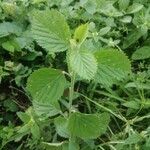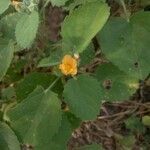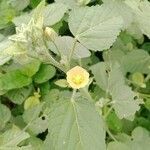Subshrubs or shrubs, to 1.5 m. Stems erect, stellate-tomentose. Leaves: stipules free from petiole, 1-veined, linear, 5–8 mm, shorter than petiole; petiole 10–25 mm, to 1/2 length of blade, stellate-tomentose; blade broadly cordate to ovate-lanceolate, to 6 cm, reduced distally, 1–2 times longer than wide, base cordate, margins dentate to base, apex acute, surfaces softly velvety-tomentose. Inflorescences axillary, usually subsessile, crowded panicles or corymbs, sometimes solitary flowers. Pedicels 0.2–0.4 cm, enlarging slightly in fruit, shorter than calyx. Flowers: calyx prominently ribbed, 6–7 mm, densely stellate-tomentose, lobes ovate; petals yellow-orange, often with darker reddish base, 8–11 mm; staminal column hairy; style 8–14-branched. Schizocarps oblate-conic, 6–7 mm diam., apically hairy; mericarps 8–14, 4–5 mm, dorsally smooth, apex spined, spines to 2 mm, retrorsely barbed (variably developed, rarely suppressed). 2n = 28.
Subshrubs erect, ca. 1 m tall. Branchlets, stipules, petioles, and leaves densely stellate strigose; branchlets and petioles velutinous, hairs ca. 3 mm. Stipule filiform, ca. 5 mm; petiole 1-2.5 cm; leaf blade ovate, 1.5-5 × 1-4 cm, abaxially velutinous on veins, base minutely cordate or rounded, margin crenate, apex obtuse to rounded. Flower solitary or fascicled, axillary or terminal. Pedicel 5-15 mm, densely stellate pilose and with long hairs, articulate in distal part. Calyx cup-shaped, lobes triangular, 5-6 mm, densely stellate pilose and with long hairs. Corolla yellow, ca. 1.5 cm in diam.; petals oblong, 6-8 mm. Filament tube ca. 6 mm, hirsute. Schizocarp 6-8 mm in diam.; mericarps 10, with vertical grooves, apex 2-awned, awn 3-4 mm, exceeding calyx, retrorsely barbed. Seeds long ovoid, apex hairy. Fl. year-round.
Leaf-lamina 3–7 × 1–4 cm., broadly ovate-to suborbicular-subcordate, apex usually obtuse to rounded less often acute to acuminate, margin irregularly crenate, base somewhat cordate to rounded, ± densely stellate-pubescent on both surfaces, lower surface paler and with a denser indumentum of longer hairs, upper surface sometimes glabrescent; petiole 1–3 cm. long, stellate-tomentose and often with additional longer patent hairs; stipules c. 5 mm. long, filiform, weak.
An erect woody shrub about 0.4 to 1 m high. It keeps growing from year to year. It is covered with short hairs mixed with long hairs. These make the plant feel soft. The leaf stalk is 1-2.5 cm long. The leaves are one after the other and heart shaped at the base. They are toothed at the edge and 1.5 to 4.5 cm long. The flowers are yellow and occur in the axils of the leaves. The fruit are about 6-8 mm across. They have 20 fine bristles on the top.
Flowers bright yellow, fasciculate, mainly towards the tips of the branches or, on terminal and lateral branches bearing small leaves, in a subspicate inflorescence, or sometimes solitary in the axils of the lower leaves; pedicels 4–20 mm. long, the longer ones articulated near the apex.
Annual or perennial herb or shrub, 0.5-1.0 m high. Leaves broadly ovate-to suborbicular-subcordate. Flowers clustered in upper axils. Mericarps with 2 long erect awns covered with short, reflexed, stiff hairs. Flowers yellow.
Erect annual or perhaps sometimes perennial suffrutex 0·5–1 m. tall; stems stellate-pubescent and usually with additional patent simple hairs up to 3 mm. long, ultimately glabrous.
Mericarps 8–12 (normally 10), usually c. 7 mm. long, somewhat strigose and birostrate at the apex; awns 3–4 (6) mm. long, exceeding the calyx, erect, finely retrorse-hispid.
Calyx 4–6 × 8 mm., campanulate-cupuliform, densely and softly tomentose, lobed to about the middle; lobes triangular.
Seeds c. 2 × 2 mm., glabrous except for some hairs around the hilum.
An erect, softly downy perennial, up to 5 ft. high
Staminal tube hirsute.
Petals c. 7 mm. long.
Bright yellow flowers





